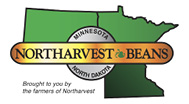Common Arthropod Pests of Dry Beans in North Dakota (E2023, June 2021)
Black Bean Aphid (Figure 1)
Nymph: Similar to adult but smaller, black body with slight reddish tint, always without wings.
Adult: Small, about 1/16 inch long, pear-shaped, black body with white and black legs, two cornicles (look like tailpipes) at posterior end, winged or wingless.
Important vectors of viral diseases.
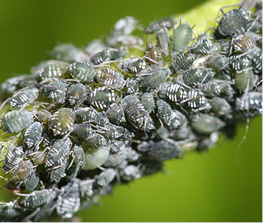
- Figure 1. Black bean aphids. (C. DiFonzo, Michigan State University)
Grasshopper
Nymph (Figure 2): Resembles the adult, but smaller and without fully developed wings (wing pads only).
Adult (Figure 3): Size varies by species (1 to 1¾ inch long), brown to grayish-green, prominent head, large compound eyes, enlarged hind legs for jumping. Fully developed wings.
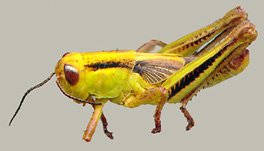
- Figure 2. Grasshopper nymph. (P. Beauzay, NDSU)
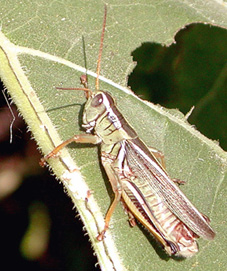
- Figure 3. Two-striped grasshopper adult. (J. Knodel, NDSU)
Potato Leafhopper
Nymph (Figure 4): Similar to adult, but smaller, greenish yellow
and wingless.
Adult (Figure 5): Less than 1/8 inch long, narrow, wedge-shaped, pale green body. Wings are translucent green and folded over the back at rest. Nymphs and adults jump or walk rapidly sideways when disturbed. Migrates into North Dakota each spring.
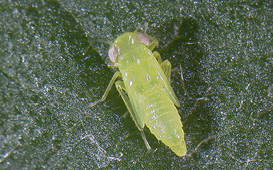
- Figure 4. Potato leafhopper nymph. (J. Knodel, NDSU)
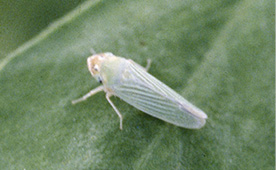
- Figure 5. Potato leafhopper adult. (S. Brown, University of Georgia, Bugwood.org)
Foliage Feeding Caterpillars
Green Cloverworm
Caterpillar or larva (Figure 6): Mature larva about 1¼ inches long. Pale green, with one long narrow white stripe on each side, three pairs of fleshy prolegs at the center part of the body and one pair of prolegs at the rear end. Moves in
a looping behavior.
Adult (Figure 7): Wingspan of 1 inch. Dark brown moth with spots. When moth rests, wings form a triangle. Migrates into North Dakota each spring.
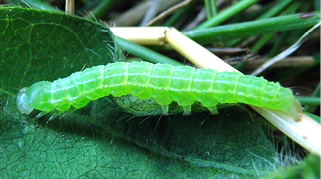
- Figure 6. Green cloverworm larva. (J. Gavloski, Manitoba Agriculture, Food and Rural Initiatives)
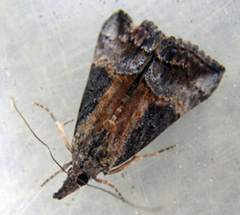
- Figure 7. Green cloverworm adult. (J. Gavloski, Manitoba Agriculture, Food and Rural Initiatives)
Painted Lady Butterfly/Thistle Caterpillar
Caterpillar or larva (Figure 8): Mature larva about 1½ inches long. Brown to black with yellow striping along each side of the body and covered with branched spiny hairs, giving a prickly appearance. Webbed nest in curled leaves where they feed on foliage. Black pellets (frass) inside web.
Adult (Figure 9): Wing span of 2½ to 3½ inches. Forewings red-orange and brown with black and white spots. Hindwings orange-brown with four black “eye spots” along the edge. Feeds on flower nectar and aphid honeydew. Migrates into North Dakota each spring.
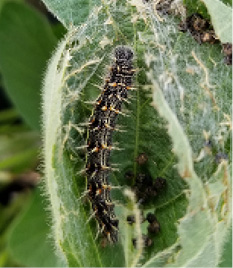
- Figure 8. Thistle caterpillar in webbed nest. (V. Calles-Torrez, NDSU)
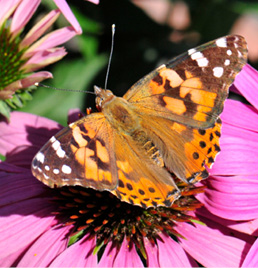
- Figure 9. Painted lady butterfly. (P. Beauzay, NDSU)
Armyworm
Larva (Figure 10): Light tan to dark greenish-brown caterpillar with three longitudinal stripes (pale orange, white, brownish and/or black) on smooth and almost hairless body, about 1½ to 2 inches long when mature. Defoliates leaves/pods, usually in moist, shady areas where lodging is present.
Adult (Figure 11): Light brown moth with a conspicuous white spot about the size of a pinhead on each front wing, wingspan of 1½ inches.
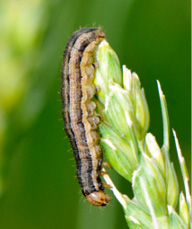
- Figure 10. Armyworm larva. (P. Beauzay, NDSU)
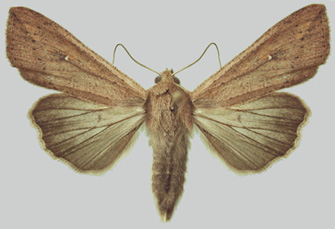
- Figure 11. Armyworm adult. (J. Fauske, NDSU)
Cutworm
Larva (Figure 12): Black to pale gray body with markings (spots or stripes), about 1½ inches long when mature.
Adult (Figure 13): Dark gray, brown or dull yellow or tan moths with dark wing markings, robust body, wingspan of 1¼ to 1½ inches.
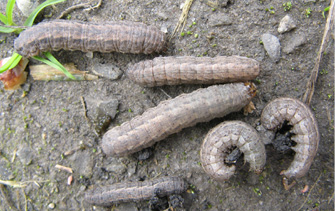
- Figure 12. Dingy cutworm larva. (J. Gavloski, Manitoba Agriculture, Food and Rural Initiatives)
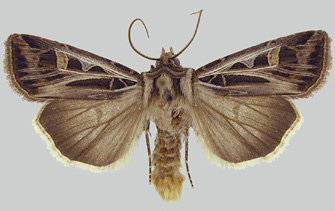
- Figure 13. Dingy cutworm adult. (G. Fauske, NDSU)
Seed Corn Maggot
Larva (Figure 14): Maggot-like, about ¼ inch long, cylindrical, legless, pale yellow-white and sharply pointed at the head end with small black mouth hooks. Found in hollowed-out seed, burrowing in emerging stem and cotyledon leaves. Larvae kill seedlings, preventing bean emergence (Figure 15).
Adult (Figure 16): Grayish-brown fly, about ¼ inch long.
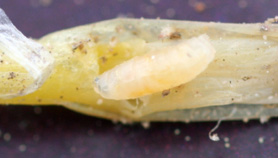
- Figure 14. Seed corn maggot larva. (W. Cranshaw, Colorado State University, Bugwood.org)
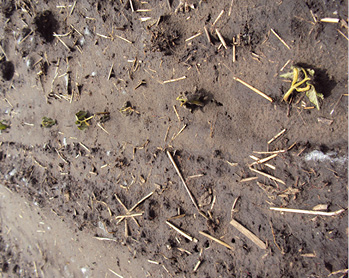
- Figure 15. Damage to dry bean row from seed corn maggot. (J. Knodel, NDSU)
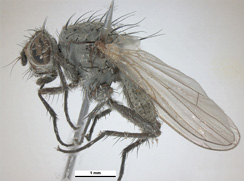
- Figure 16. Seed corn maggot adult. (Pest and Diseases Image Library, Bugwood.org)
Spider Mite
Immature: Similar to adult, but smaller with six to eight legs.
Adult (Figure 17): Very small, less than 0.02 inch (magnification is needed to see them in detail), green, yellow or orange body, two dark spots on the abdomens for two-spotted spider mite, eight legs. Located on the underside of leaves. Produce spiderlike webbing (Figure 18) and stippling on leaves (Figure 19).
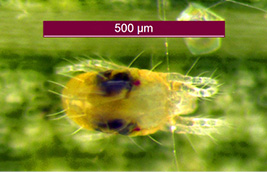
- Figure 17. Two-spotted spider mite. (P. Beauzay, NDSU)
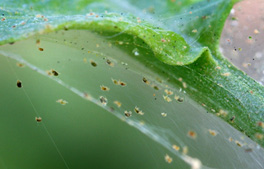
- Figure 18. Webbing from two-spotted spider mites. (D. Cappaert, Michigan State University, Bugwood.org)
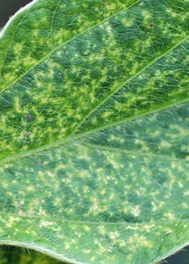
- Figure 19. Stippling injury from two-spotted spider mites. (J. Knodel, NDSU)
Printing support was received from the Northarvest Bean Growers Association and the U.S. Department of Agriculture’s National Institute of Food and Agriculture, Crop Protection and Pest Management Program grant no. 2017-70006-27144
